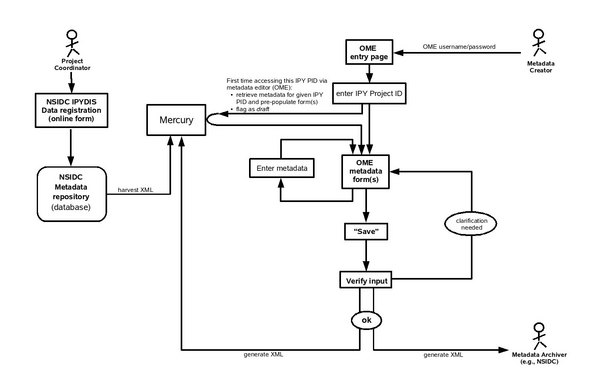Difference between revisions of "SolutionsUseCase CoastsOcean Arctic 2a"
| Line 48: | Line 48: | ||
===Failure Outcomes=== | ===Failure Outcomes=== | ||
| − | + | * Required metadata fields are not complete. | |
| − | * | + | * Metadata are not available to data discovery processes. |
| − | * | ||
==General Diagrams== | ==General Diagrams== | ||
Revision as of 15:52, May 14, 2007
Return to: Use_Cases
Plain Language Description
Short Definition
Background: This use case was developed during a small workshop that brought together scientists from diverse physical, biological, and social science disciplines to address how they would search for and assess interdisciplinary data to address important Arctic coastal science questions. A small breakout group also discussed scenarios for delivering metadata from their research projects to the data managers responsible for providing a means of discovering and using these data.
Purpose
- Metadata Creators don’t receive guidance regarding metadata requirements (e.g., templates, help with using self-describing data archival formats) or the archiving process.
- It is difficult and time consuming to obtain accurate metadata after the data collection/analysis period, and particularly after the metadata have been contributed to an archive. Metadata Creators are usually dissatisfied with metadata as written by Metadata Archivers (data centers). These metadata are usually gleaned from project descriptions and project documentation, and typically aren’t accurate. Too much time is spent iterating back and forth between the Metadata Creator and Metadata Archiver in an attempt to create accurate metadata.
- Data Seekers need metadata which will help them find connections between data (archive location), PIs, where/how data were obtained (project), and similar datasets. They need to be able to easily navigate from metadata to data.
- Metadata Creators don’t create metadata throughout the research process.
- Project metadata already exist in various forms in Project Funder records. Metadata Creators or Metadata Archivers frequently need to re-enter project metadata when populating dataset metadata records, even though those metadata could be retrieved directly from the Project Funder.
Describe a scenario of expected use
A Metadata Creator wishes to contribute metadata to a Metadata Archiver. The actual data will be archived by the Metadata Creator in the form of files available via FTP.
Definition of Success
Metadata are discoverable through Metadata Archiver interface.
Formal Use Case Description
Use Case Identification
- Use Case Designation
- CoastsOcean.Arctic.2a
- Use Case Name
- Contribute Metadata Representing Outcome of Arctic Coastal Processes Research
Revision Information
- Prepared by:
- Julia Collins
- National Snow and Ice Data Center
- 17:43, 14 May 2007 (EDT)
- Version 0.1
- Modified by:
- <Modifier Name/Affil>, <Date/time>, <Brief Description>
Definition
Through this use case, the Metadata Creator contributes metadata to a Metadata Archiver. These metadata are the foundation of the use case described by SolutionsUseCase_CoastsOcean_Arctic_1a.
Successful Outcomes
- Metadata are complete and available to Metadata Archiver.
Failure Outcomes
- Required metadata fields are not complete.
- Metadata are not available to data discovery processes.
General Diagrams
Schematic of Use case
Use Case Elaboration
This section is intended to be completed with the details of the use case that are required for implementation. This section is not intended to be filled in by an application user.
Actors
Primary Actors
- Metadata Creator
Other Actors
- Project Coordinator
- Metadata Archiver
Preconditions
- 1.Collection metadata have been entered into the system
- 2.Collection metadata have been validated
- 3.Collection metadata have been published
Postconditions
- 1.Datasets or granules have been identified within the system for further action
- 2.Appropriate action (i.e. Map, download, process) controls have been provided to the user to initiate that action.
- 3.Controls are provided to the user to refine the criteria used to 'discover' the dataset.
Normal Flow (Process Model)
- 1)The user selects the 'dataset discovery' tool collection from the user interface
- 2)The user performs a 'simple' search using a simple interface that searches commonly queries dataset attribute fields for matching text/terms.
- 3)The results of the search are presented to the user with appropriate action controls associated with the datasets.
- 4)The user selects one of the action controls to 'use' the identified dataset(s) in a specified action (i.e. Visualization, download, processing)
Alternative Flows
- 1)The user selects the 'dataset discovery' tool collection from the user interface
- 2)The user selects a control that provides access to an advanced search tool that supports spatial, temporal, and parametric search methods. Flow then extends to EIE11-EIE14.
Special Functional Requirements
None
Extension Points
- <Cluster>.<SubArea>.<number>.<letter+1> something added or a variant.
E.g. AQ.Smoke.1.b something added or a variant
- <Cluster>.<SubArea>.<number>.<letter+2> something added or a variant
- <Cluster>.<SubArea>.<number>.<letter+3> something added or a variant
Diagrams
Use Case Diagram
State Diagram
Activity Diagram
Other Diagrams
Non-Functional Requirements
Performance
Reliability
Scalability
Usability
Security
Other Non-functional Requirements
Selected Technology
Overall Technical Approach
Architecture
Technology A
Description
Benefits
Limitations
Technology B
Description
Benefits
Limitations
References
None
